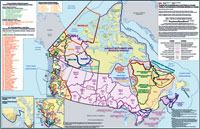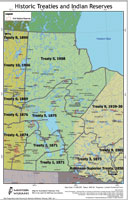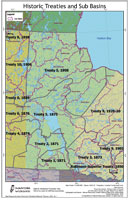
Aboriginal Rights & Title,
Treaties & Traditional Territory
Land Ownership from an Aboriginal PerspectiveThe concept of land ownership was completely alien to the Native peoples. From an Aboriginal cultural and spiritual perspective, land cannot be bought or sold. They saw themselves as the spiritual guardians of the land, not its actual owners. Land was considered a gift from the Creator or Great Spirit, and its resources were to be used for survival purposes only.
Thus, the concept of 'surrendering' land was one that caused great confusion within Aboriginal communities, and may have contributed to further injustices against the Aboriginals - notably, the signings of the Upper Canada and other treaties. This Aboriginal view of land ownership is one of the roots to many Aboriginal rights and land issues today. Idle No MoreView Manitoba Wildlands Idle No More page
Aboriginal RightsAs one scholar noted, "There can be no answer to the question 'what are Aboriginal rights?' that is not in the terms of the dominant, non-Native society...any answer to the question 'what are Aboriginal rights?' is already an attempt to confine, constrain, demarcate and delimit those rights and consequently part of the process of confining, constraining, demarcating and delimiting Aboriginal peoples."Source: Kulchyski, P. Unjust Relations: Aboriginal Rights in Canadian Courts
 Aboriginal rights need to also be considered in the context of the patchwork process of colonization, and the relationship that has developed between the Crown and Aboriginal people from the earliest treaties to present government policies. Many would argue that Aboriginal rights can be traced in law directly to the Royal Proclamation of 1763, and arguably, to the earliest treaties and the principles of British common law. Recent interpretations of Aboriginal Rights by the Supreme Court hold that the Crown, in its dealings with Aboriginal peoples, has accepted that they "would retain their lands, as well as their political and cultural institutions and customary laws, unless the terms of treaties ruled this out or legislation was enacted to the contrary". Furthermore, the Crown has "assumed a general obligation to protect Aboriginal peoples and their lands and generally look out for their best interests, in what the judges have described as a fiduciary or trust-like obligation".
Aboriginal rights need to also be considered in the context of the patchwork process of colonization, and the relationship that has developed between the Crown and Aboriginal people from the earliest treaties to present government policies. Many would argue that Aboriginal rights can be traced in law directly to the Royal Proclamation of 1763, and arguably, to the earliest treaties and the principles of British common law. Recent interpretations of Aboriginal Rights by the Supreme Court hold that the Crown, in its dealings with Aboriginal peoples, has accepted that they "would retain their lands, as well as their political and cultural institutions and customary laws, unless the terms of treaties ruled this out or legislation was enacted to the contrary". Furthermore, the Crown has "assumed a general obligation to protect Aboriginal peoples and their lands and generally look out for their best interests, in what the judges have described as a fiduciary or trust-like obligation".
Source: Kulchyski, P. Unjust Relations: Aboriginal Rights in Canadian Courts, quotes from Slattery, B. Understanding Aboriginal Rights Canadian Bar Review 66: 727 pg. 733-35
Indian and Northern Affairs Canada describes Aboriginal rights as: Rights that some Aboriginal peoples of Canada hold as a result of their ancestors' longstanding use and occupancy of the land. The rights of certain Aboriginal peoples to hunt, trap and fish on ancestral lands are examples of Aboriginal rights. Aboriginal rights will vary from group to group depending on the customs, practices and traditions that have formed part of their distinctive cultures.
Source: Indian and Northern Affairs Canada
Treaty Two Serves Notice: Peat Mines & Irrigation Chief Norman Bone, co-chair of the Treaty 2 First Nations known collectively as Anishinaabe Agawidiiwinan, has served notice to the Honourable Gord Mackintosh that they regard pending provincial government decisions regarding new peat mines as having strong potential for serious negative impacts on the rights and of the First Nations.
Chief Norman Bone, co-chair of the Treaty 2 First Nations known collectively as Anishinaabe Agawidiiwinan, has served notice to the Honourable Gord Mackintosh that they regard pending provincial government decisions regarding new peat mines as having strong potential for serious negative impacts on the rights and of the First Nations."We believe it is incumbent upon the Government to abstain from any decisions that would result in the issuing of any peat licenses until such time as its constitutionally mandated duties have been fulfilled," said Chief Bone. Canadians are increasingly aware of the severe environmental issues associated with peat. For centuries peat was used as a source of fuel, and in modern times it is commonly used as a growing medium in gardening. Environment scientists are warning, however, that peat mining is an incredibly destructive and unnecessary industry. Also the entire watershed of the Little Saskatchewan River is within the boundaries of Treaty No. 2 in which the First Nations agreed to share their lands for purposes of "immigration and settlement." On July 5, 2012 the Government of Manitoba issued Environment Act License No. 3010 to the "Daly Irrigation Development Group" for the construction and operation of an irrigation system in the Rural Municipality of Daly. Chief Norman Bone therefore also served notice to Gord Mackintosh that they regard the provincial government's decision to issue a license to the Daly Irrigation Development Groups as having strong potential for serious negative impact on the rights and interests of First Nations. "We believe it is incumbent upon the Government to stay the license until such time as its duties have been fulfilled," Chief Bone said in the Treaty 2 notice. The river's fragile ecosystem provides critical habitat for several endangered and at-risk species. View July 27, 2012 Treaty Two Press Release on Peat Mines (PDF)View July 27, 2012 Treaty Two Press Release on Little Saskatchewan Irrigation (PDF) Source: Treaty Two
Recent Research - Aboriginal Peoples in Canada"A Brief History of Effects of Colonialism on First Nations in Canada" by Tony Oliver, a student at Simon Fraser University. Canada Signs UNDRIP... Well Sorta When the UN General Assembly adopted the UN Declaration on the Right of Indigenous Peoples (UNDRIP) September 13, 2007 only 4 countries (New Zealand, Australia, the United States and Canada) opposed the Declaration citing concerns that it conflicted with their countries' own laws.
When the UN General Assembly adopted the UN Declaration on the Right of Indigenous Peoples (UNDRIP) September 13, 2007 only 4 countries (New Zealand, Australia, the United States and Canada) opposed the Declaration citing concerns that it conflicted with their countries' own laws.More than three years later, Canada has changed positions and offered conditional "support" for UNDRIP. "The Declaration is an aspirational document which ...is a non-legally binding document that does not reflect customary international law nor change Canadian laws," declares the Canadian Government's letter of support. Canada's Assembly of First Nations noted: "...exception to the statement that the UNDRIP does not reflect customary international law", but added, "[w]hile this in itself doesn't address our urgent needs, it does say that Canada is listening and that Canada is willing to work with us to achieve the standards set out in the UNDRIP." "Now is our time to work together towards a new era of fairness and justice for First Nations and a stronger Canada for all Canadians, guided by the Declaration's core principles of respect, partnership and reconciliation," stated National Chief Shawn Atleo. "Canadians need to understand that the purpose of instruments like the declaration is to encourage governments to change policies and laws that are discriminatory or that fail to uphold and fulfill the human rights protections guaranteed to Aboriginal Peoples," said National Inuit Leader Mary Simon. The United Nations Declaration on the Rights of Indigenous Peoples (UNDRIP), a non-binding document, recognizes indigenous people's basic human rights and rights to self-determination, language, equality and land, among other rights. Since the 2007 vote, New Zealand and Australia have since endorsed the declaration. The United States - the only country now left to not endorse the declaration - is reviewing its decision. View November 12, 2010 Government of Canada articleView November 12, 2010 Government of Canada news release View November 12, 2010 United Nations news release View November 12, 2010 CBC News article View November 12, 2010 Toronto Sun article View November 12, 2010 Rabble.ca article View September 18, 2007, May 12, 2010, September 29, 2010 Manitoba Wildlands news item View United Nations Declaration on the Rights of Indigenous Peoples View United Nations information website  Download November 12, 2010 Assembly of First Nations news release (PDF) Download November 12, 2010 Assembly of First Nations news release (PDF) Download November 12, 2010 Assembly of First Nations backgrounder (PDF) Download November 12, 2010 Assembly of First Nations backgrounder (PDF) Download November 13, 2010 Four Arrows summary (PDF) Download November 13, 2010 Four Arrows summary (PDF)Sources: Government of Canada, Assembly of Chiefs, United Nations
Controversy Grows Over Fish Lake Mine The second attempt by Taseko Mines to obtain required environmental licenses for the "New Prosperity Mine", which once again threatens Fish Lake in British Columbia's interior, continues to attract public controversy.
The second attempt by Taseko Mines to obtain required environmental licenses for the "New Prosperity Mine", which once again threatens Fish Lake in British Columbia's interior, continues to attract public controversy.Taseko's first proposal was rejected November 2, 2010 by then Environmental Affairs Minister Jim Prentice. Public and First Nations concerns over impacts of mining operations on Fish Lake continue. A federal review panel found the proposed mine would cause irreparable damage to both First Nations rights and the environment, including to fish stocks and grizzly populations. The company submitted a revised proposal August 9, 2011, which was accepted by the Canadian Environmental Assessment Agency November 7, 2011. Taseko's revised project avoids draining picturesque Fish Lake, home to 80,000 rainbow trout. Instead of the original proposal to drain the lake, the lake would be surrounded by the proposed open-pit mine, unusable for the life of the mine (up to 33 years). The company admits this would essentially destroy the lake due to leaching from mine waste. "There is something seriously wrong with our assessment process when a company like Taseko can simply re-submit a mining proposal after it has been soundly rejected. It would be a far better use of time and money to focus on mining proposals that are more environmentally appropriate, and have support of First Nations," said Sierra Club BC Executive Director George Heyman. Nearby Tsilqhot'in First Nation was granted a court injunction to stop Taseko from undertaking exploratory work December 2011. The band wanted the court to keep the mining firm out of its territory, until the B.C. Appeal Court rules on the band's case involving aboriginal title. After several community meetings, the Tsilhqot'in Nation agreed to stop fighting and litigating against Taseko on test drills, while keeping its eye on the real goal, which is to make sure the mine itself never gets built. "This was not a decision we made lightly," said Chief Marilyn Baptiste of the Xeni Gwet'in, a community in the Tsilhqot'in National Government, "But as a Nation, we've made a decision to focus our energies on the real battle of defeating this project, full-stop." Taseko Mines filed a Notice of Civil Claim against the Western Canada Wilderness Committee March 1st, accusing the Wilderness Committee and its outreach director Sven Biggs for "a series of false and defamatory statements concerning Taseko and its proposed New Prosperity Gold-Copper Project." The Wilderness Committee has vowed to fight the civil claim. "This ill-conceived mine proposal should be turned down once and for all. That's our view and we're standing by it. We believe this court action stifles fair comment about Taseko's environmentally risky mine proposal. People should be able to enjoy full participation in the Federal Environmental Review process, including the right to comment – without fear of time-consuming and costly litigation," said Joe Foy, national campaign director for the Wilderness Committee. View March 2, 2012 Indian Country Today articleView March 2, 2012 Williams Lake Tribune coverage View March 2, 2012 CTV coverage View February 29, 2012 Tsilhqot'in First Nation Press Release View February 16, 2012 Sierra Club BC coverage View November 7, 2011 Sierra Club BC press release View October 28, 2011 Manitoba Wildlands news item Sources: Sierra Club of BC, Williams Lake Tribune, Indian Country Today
BC First Nations Win Fish Lake Injunction The Tsilhoquo'in First Nation has been granted an injunction preventing Taseko Mines from working around its proposed gold and copper mine near Williams Lake, British Columbia. All Tsilhqot'in First Nations support the legal action for an injunction. The Canadian federal government recently ordered a new environmental assessment for the second mine proposal. The federal government did not approve the first mine proposal.
The Tsilhoquo'in First Nation has been granted an injunction preventing Taseko Mines from working around its proposed gold and copper mine near Williams Lake, British Columbia. All Tsilhqot'in First Nations support the legal action for an injunction. The Canadian federal government recently ordered a new environmental assessment for the second mine proposal. The federal government did not approve the first mine proposal.The injunction prevents Taseko employees from conducting exploration work, which had been permitted by the BC government. Tsilhoquo'in Chief Marilyn Baptiste says the latest mine proposal will be even worse on the environment than the first proposal. "Little Fish Lake as well as Upper Fish Creek will be destroyed. And Lower Fish Creek will be destroyed by their pit," argues Baptiste. BC Supreme Court judge Christopher Grauer has ruled the First Nation was not properly consulted on two permits granted to Taseko by the provincial government. The injunction will be in force until the First Nation can launch a judicial review over the provincial government permits. Jay Nelson, the band's lawyer indicated, "I think it's the right decision. It gives everybody some space now to try to get the consultation process right for these approvals, so it gives the Crown a chance to come back and do its job properly." Watch First Nations Stand Their Ground Against Prosperity Mine at BC Supreme CourtView December 2, 2011, CTV News article View December 2, 2011, The Prince George Citizen article View Protect Fish Lake website View December 2, 2011, Tsilhqot'in National Government release Source: CTV News
Prosperity Mine Denied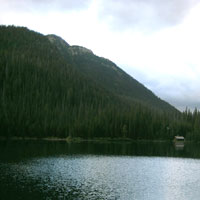 The Government of Canada denied federal authorizations for of Taseko Mines Ltd. to proceed with the Prosperity Mine Project, November 2, 2010. "The significant adverse environmental effects of the Prosperity project cannot be justified as it is currently proposed," said Environment Minister, Jim Prentice.
The Government of Canada denied federal authorizations for of Taseko Mines Ltd. to proceed with the Prosperity Mine Project, November 2, 2010. "The significant adverse environmental effects of the Prosperity project cannot be justified as it is currently proposed," said Environment Minister, Jim Prentice.Taseko Mines Ltd. planned to drain Teztan Biny (Fish Lake) in central British Columbia (B.C.) to access gold and copper deposits and make room for a toxic tailings pond. A Canadian Environmental Assessment Agency (CEAA) panel report found that creation of the mine and destruction of Teztan Biny (Fish Lake) would impose irreversible harm to the environment, fish and wildlife and on First Nations rights, lives, culture and spirituality. The proposed Prosperity open-pit mine is on the traditional lands of the Xeni Gwet'in First Nation, a member of the Tsilhqot'in National Government. "We were very pleased to see many of our concerns about this project reflected in the Panel Report," commented Ramsey Hart of Mining Watch Canada, "We are even more pleased to see the government respect those findings and reject the project." "Now we must close the legislative loophole that allows destruction of Canada's freshwater bodies for toxic mine tailings," said Sierra Club B.C. Executive Director George Heyman, referring to changes made to Canada's Fisheries Act which allow metal mining corporations to use Canadian lakes to dispose of millions of tonnes of toxic waste rock and tailings. Fish Lake would have been Canada's fifth pristine natural water body authorized for as a tailing pond. First Nations Women Advocating Responsible Mining (FNWARM) founding member Chief Marilyn Baptise and her fellow Tsilhqot'in National Government chiefs intend to follow up their recent victory saving Fish Lake with a court appeal to establish their Title and Right. Takla Lake First Nation Chief Dolly Abraham explained, "before we can start to deal with individual proposals effectively we need Land Use Plans that clearly state where mining - and other resource extraction - can be pursued, and where it cannot - and this must take into account the accumulative effects of all projects on the environment." View November 2, 2010 Environment Canada news releaseView November 2, 2010 Sierra Club of B.C. news release View November 3, 2010 Mining Watch Canada news release View November 2, 2010 CBC News article View November 3, 2010 Maple Ridge News article View November 9, 2010 FNWARM press release View September 22, 2010 Manitoba Wildlands news item View April 7, 2010 Manitoba Wildlands news item Source: Environment Canada, Sierra Club of B.C., Mining Watch Canada, FNWARM
Fish Lake Tailings Pond/Prosperity Mine Protests National, regional and affected local BC First Nations have sent a clear message to the federal government - the proposed Prosperity mine in British Columbia (B.C.) cannot be allowed to proceed. National, regional and affected local BC First Nations have sent a clear message to the federal government - the proposed Prosperity mine in British Columbia (B.C.) cannot be allowed to proceed.Taseko Mines Ltd. plans to drain Teztan Biny (Fish Lake) in central B.C. to access gold and copper deposits and make room for a waste rock dump and toxic tailings pond. The proposed Prosperity open-pit mine is on the traditional lands of the Xeni Gwet'in First Nation, a member of the Tsilhqot'in National Government. Tsilhqot'in National Government (TNG) is joined by the B.C. Assembly of First Nations, Union of BC Indian Chiefs, Nishnawbe Aski Nation (NAN) and BC First Nations, in addition to 12 environmental organizations from across Canada, in speaking out against the proposed mine. "There are no options open to the federal Government - it must respect the findings of significant and irreparable harm to the environment and First Nations rights and culture that were delivered in the Canadian Environmental Assessment Agency's (CEAA) review Panel Report 2010," said Chief Marilyn Baptiste, of Xeni Gwet'in. The CEAA panel report found that creation of the mine and destruction of Teztan Biny (Fish Lake) would impose irreversible harm to the environment, fish and wildlife and on First Nations rights, lives, culture and spirituality. It also found the proposal does not meet standards required under federal fisheries and navigable waters Act and that the proposed mitigation measures would not address environmental harm caused by the mine. Under terms of reference for the CEAA panel review, the federal government is to deliver a decision on the mine in September, 2010. Taseko Mines Ltd. has been assuring investors that the mine will proceed and that approval will be granted rapidly. This has raised concerns that the company seems to have no question that its mine will be approved. The TNG wrote Federal Environment Minister Jim Prentice in June 2010 specifically requesting assurances that the government had not predetermined the mine would go ahead regardless of the CEAA panel review findings. To date, the TNG has not been granted any meetings with the Minister. Visit Tsilhqot'in First Nations websiteVisit Protect Fish Lake website View September 2, 2010 Union of BC Indian Chiefs press release View September 2, 2010 Canadian News Wire article View September 2, 2010 Sierra Club press release View September 2, 2010 CBC News article View September 2, 2010 Globe and Mail article View September 3, 2010 Indigenous Peoples article View September 8, 2010 Aboriginal Peoples Television Network article and video View September 9, 2010 Council of Canadians article View September 16, 2010 Globe and Mail article Watch September 16 2010, Video Of Xeni Gwit'in Elder On Protecting Fish Lake View September 20, 2010 Aboriginal Peoples Television Network article Source: Indigenous Peoples, CBC, Sierra Club, Globe and Mail
Manitoba Apologizes to Sayisi Dene The Manitoba government apologized for its role in the forced relocation of the Sayisi Dene in the 1950s. The apology was made at a ceremony in Churchill August 3rd, 2010 by Northern Affairs Minister Eric Robinson to Sayisi Dene Chief Jimmy Thorassie and Churchill Mayor Michael Spence. The Manitoba government apologized for its role in the forced relocation of the Sayisi Dene in the 1950s. The apology was made at a ceremony in Churchill August 3rd, 2010 by Northern Affairs Minister Eric Robinson to Sayisi Dene Chief Jimmy Thorassie and Churchill Mayor Michael Spence.The relocation, now considered an abject failure, saw hundreds of people moved to Churchill from their traditional homes in northern Manitoba. In a release, the province states the decision to relocate the Dene community at Duck Lake prior to 1956 was in part due to Manitoba wildlife officials who stated the traditional hunting practices of the Dene contributed to a perceived decline of area caribou herds. After relocation, it was determined the caribou herd the Sayisi Dene had relied upon for generations was in fact healthy. In less than two decades, nearly one-third of the Sayisi Dene died as a result of illness, violence, poverty and racism experienced on the outskirts of Churchill. The forced relocation of the Sayisi Dene was documented in the reports of the Manitoba's 1991 Aboriginal Justice Inquiry and Canada's 1996 Royal Commission on Aboriginal Peoples. An apology and compensation were recommended "This is an important step on the path to reconciliation and healing," says Chief Thorassie. "We have a responsibility to work together to build the future we want for our children despite a legacy of hurt born of past government mistakes." Manitoba has proposed to provide more than 13,000 acres of Crown land, separate from any treaty land entitlement, to help address the effects of relocation. The Sayisi Dene were moved to Tadoule Lake in 1973 at the request of community. View August 3, 2010 Government of Manitoba press releaseView August 3, 2010 Winnipeg Free Press article View August 4, 2010 Winnipeg Free Press article View August 3, 2010 CBC News article Source: Winnipeg Free Press, Government of Manitoba
WAHBUNG: Our Tomorrows Download October 1971 report WAHBUNG: Our Tomorrow (PDF) Download October 1971 report WAHBUNG: Our Tomorrow (PDF)View Assembly of Manitoba Chiefs Preface for WAHBUNG: Our Tomorrow Sources: Assembly of Manitoba Chiefs
Aboriginal Water RightsView Manitoba Wildlands' Water pages section on Aboriginal Water Rights Aboriginal TitleIf there is to be an infringement on Aboriginal title the government must recognize its fiduciary relationship with Aboriginal people, and ensure that there is as little infringement as possible, that fair compensation is made available and that the Aboriginal group has been consulted. In 1973, the Supreme Court of Canada first recognized land rights based on Aboriginal title. Source: Summary, Indian and Northern Affairs Canada
Indian and Northern Affairs Canada describes Aboriginal title as: A legal term that recognizes Aboriginal interest in the land. It is based on their longstanding use and occupancy of the land as descendants of the original inhabitants of Canada.
Source: Indian and Northern Affairs Canada
Treaties |
|||||
| A "Treaty" is a written agreement or contract made between two or more nations or sovereigns, formally signed by commissioners properly authorized, and solemnly ratified by the several sovereigns or the supreme power of each state. In Canada, treaties are constitutionally recognized agreements between the Crown and Aboriginal nations. |
Historical Treaties of Canada Map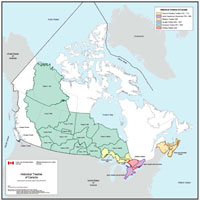 Larger Version |
| The signing of treaties in Canada extinguished Aboriginal title (but not Aboriginal rights) within those lands delineated by the treaty. (However, there are lands in Canada where treaties were never signed and Aboriginal title to land was never extinguished. Such is the case in most of British Columbia.) View Treaty texts The Royal Proclamation of 1763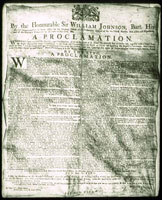 The Royal Proclamation of 1763, issued by King George III after the fall of Quebec and the Treaty of Paris, is a primary basis for our understanding of the legal nature of Aboriginal title and an historical root of the treaty process. It articulated the basic principles for treaty making with Aboriginal peoples. The Royal Proclamation of 1763 decreed that Aboriginal peoples should not be disturbed in their use and enjoyment of the land and it declared that only the Crown could acquire land from Aboriginal peoples, and only through treaty-making. It set the stage for the negotiation of legally binding documents with Aboriginal peoples on a wide variety of issues and its provisions influenced the treaty process as well as the designation of reserve land, which still take place in accordance with the Indian Act.
The Royal Proclamation of 1763, issued by King George III after the fall of Quebec and the Treaty of Paris, is a primary basis for our understanding of the legal nature of Aboriginal title and an historical root of the treaty process. It articulated the basic principles for treaty making with Aboriginal peoples. The Royal Proclamation of 1763 decreed that Aboriginal peoples should not be disturbed in their use and enjoyment of the land and it declared that only the Crown could acquire land from Aboriginal peoples, and only through treaty-making. It set the stage for the negotiation of legally binding documents with Aboriginal peoples on a wide variety of issues and its provisions influenced the treaty process as well as the designation of reserve land, which still take place in accordance with the Indian Act.
Source: Bloorstreet.com, Turtle Island Native Network, Indian and Northern Affairs Canada
View text of the Royal Proclamation of 1763 View a map depicting the lands to which the Royal Proclamation of 1763 applied Canadian Constitution Act - Section 35View Canadian Constitution Act (1982) - Section 35 Historic Manitoba Treaties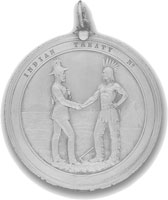 There are five historic numbered treaties that include lands in what is now Manitoba.
There are five historic numbered treaties that include lands in what is now Manitoba.Treaty 1 was signed in 1871 - View Treaty document Treaty 2 was signed in 1871 - View Treaty document Treaty 3 was signed in 1873 - View Treaty document Treaty 4 was signed in 1875 - View Treaty document Treaty 5 was signed was signed on a variety of dates beginning on September 20, 1875 and concluding on September 7, 1876 - View Treaty document There were several adhesions to Treaty 5 (where Aboriginal signed on or were added to a Treaty at a later date) that took place between June 26, 1908 and August 10, 1910. View a map of Manitoba Treaties View a larger map of Manitoba Treaties Beginning in the 1870's, some Manitoba Aboriginal communities (or Indian Bands) signed treaties with representatives of the English monarchy. Other Aboriginal communities (or Indian Bands) did not actually sign treaties, but were included in treaties through an addendum. The benefits to non-Aboriginal peoples included the continued right to live in traditional territories. Essentially, the Aboriginal communities (or Indian Bands) agreed to share the land with the newcomers in exchange for promises that the needs of their future generations would be met. Aboriginal peoples' philosophy of maintaining harmony formed the basis of these agreements. The treaties are considered sacred documents by the Aboriginal peoples of Manitoba and many Elders have passed on their recollections of the treaty negotiations through oral history. Some Elders have indicated that the written versions of treaties did not include everything that was agreed to by the negotiators. Source: Assembly of Manitoba Chiefs
View a summary of Treaties One to FiveAboriginal Traditional TerritoriesTraditional territory (off reserve) refers to the land which surrounds a First Nation community that was and still may be used by the First Nation community to practice a subsistence way of life - that is, land where hunting, trapping, fishing, and gathering activities were historically practiced, and that still may be used by the community for cultural and livelihood purposes.
Source: Campbell, T. Information North, Vol 22, no.1 (March 1996) Modern Treaties and Land Claims
Comprehensive Land Claims
Comprehensive land claims are negotiated in areas where Aboriginal title has not been dealt with by Treaty or other legal methods. The main goal of the comprehensive land claims settlement process is to provide certainty of jurisdiction over land and resources - the rights and obligations of all parties are clarified, and conflicting land ownership between the Crown and Aboriginal peoples is resolved.Historically, a major problem with the Treaty-making process had been that the federal government would only negotiate treaties if Aboriginal peoples accepted "extinguishment" of their Aboriginal rights and title - they were required to "cede, release and surrender" their aboriginal rights in exchange for treaty rights. In 1986, the federal government announced a new comprehensive claims policy to respond to concerns expressed by Aboriginal groups. The new claims policy provided alternatives to blanket extinguishment. It also widened the scope of comprehensive claims negotiations to include offshore wildlife harvesting rights, sharing of resource revenues, an Aboriginal voice in environmental decision-making and a commitment to negotiate self-government. Source: Summarized from Indian and Northern Affairs Canada, BC Treaty Commission
View Aboriginal Mapping Network's Toolbox to respond to Crown Land Referrals View a listing of Some of Canada's modern Treaties from lands claims
Treaty Land Entitlement - Manitoba
The Treaty land entitlement (TLE) process is another form of modern Treaty. The Treaty land entitlement process aims to settle the land debt owed to those First Nations who did not receive all the land they were entitled to under the historic numbered treaties signed by the Crown and First Nations. Once the amount of land is determined through the negotiation process, a First Nation may purchase federal, provincial (territorial), or private land to settle a land debt.
Source: Indian and Northern Affairs Canada
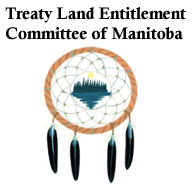 In 1977, the Treaty Land Entitlement Committee of Manitoba Inc. was formed to begin negotiations on behalf of Manitoba First Nations to settle outstanding TLEs with Canada. Not all Manitoba First Nations entitled to TLE lands are/were represented by the Manitoba TLE Committee.
In 1977, the Treaty Land Entitlement Committee of Manitoba Inc. was formed to begin negotiations on behalf of Manitoba First Nations to settle outstanding TLEs with Canada. Not all Manitoba First Nations entitled to TLE lands are/were represented by the Manitoba TLE Committee.Visit the Treaty Land Entitlement Committee of Manitoba website The province's role in the TLE process stems from the provisions of the Manitoba Natural Resources Transfer Agreement (MNRTA) of 1930. Prior to 1930 and from the time Manitoba entered Confederation in 1870, the federal government retained control over unallocated Crown lands in the province, along with other natural resources. The Manitoba Natural Resources Transfer Agreement (MNRTA) of 1930 transferred control and administration of these resources and lands to Manitoba, but required the province to provide Canada with sufficient unoccupied Crown land to fulfill outstanding TLE obligations to Manitoba First Nations. Today the MNTRA Act is contentious, and in dispute. View text of the Manitoba Natural Resources Transfer Act 1930 Although Canada, Manitoba and the TLE Committee began negotiations in 1983, the three parties did not finalize the agreement and little progress was made. It wasn't until May 29, 1997, the Manitoba Treaty Land Entitlement Framework Agreement was signed by the TLE Committee (representing 20 First Nations), Canada and Manitoba at the Opaskwayak Cree Nation, MB. This Framework Agreement is intended to fulfill Canada's outstanding debt of lands owed to the 20 TLE Committee member First Nations. View Canadian government Status Report on TLE Obligations in Manitoba Manitoba's Northern Flood Agreement
In the early 1970's, Manitoba Hydro was proceeding with its plans for hydro-electric projects on the Nelson and Churchill Rivers. As the plans for the Lake Winnipeg Regulation/Churchill River Diversion projects evolved, discussions began with five northern communities that would be affected by flooding from the projects.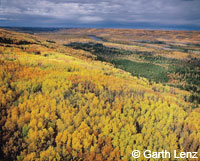 In 1974, the five affected First Nations formed the Northern Flood Committee to act jointly in consultations with Manitoba Hydro and the Governments about the projects. The Northern Flood Committee, funded by the Federal Government, negotiated the Northern Flood Agreement (NFA) and the agreement was signed in 1977. The five NFA First Nations are Split Lake - now Tataskweyak Cree Nation, Nelson House - now Nisichawayasihk Cree Nation, York Factory, Norway House and Cross Lake - now Pimicikamak Cree Nation.
In 1974, the five affected First Nations formed the Northern Flood Committee to act jointly in consultations with Manitoba Hydro and the Governments about the projects. The Northern Flood Committee, funded by the Federal Government, negotiated the Northern Flood Agreement (NFA) and the agreement was signed in 1977. The five NFA First Nations are Split Lake - now Tataskweyak Cree Nation, Nelson House - now Nisichawayasihk Cree Nation, York Factory, Norway House and Cross Lake - now Pimicikamak Cree Nation. As the effects of the project were not fully be predicted at the time the NFA was negotiated, provisions were made for future remedial and compensatory activities:
View text of the Northern Flood Agreement Visit the Northern Flood Agreement Office of the Arbitrator website Implementation of the NFA proved difficult. In 1986, the Northern Flood Committee Inc. proposed that a comprehensive implementation agreement be developed. Through the 1990s, Tataskweyak Cree Nation, York Factory Cree Nation, Nisichawayasihk Cree Nation, and Norway House Cree Nation signed Comprehensive Implementation Agreements (CIAs) with Canada, Manitoba and Manitoba Hydro. In the case of Norway House, their CIA is known as the Master Implementation Agreement (MIA). View the four settlement Agreements under the NFA
Recent Court Decisions - Aboriginal Rights |
||||||
Métis Lands
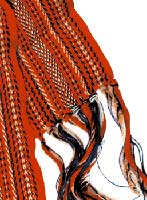 The first Métis people were the children of unions between Aboriginal women (Woodland Cree, Ojibway, Saulteaux, and Menominee) and European men (French Canadian and/or Celtic settlers). These children of mixed ancestry gradually established distinct communities outside of Aboriginal and European cultures and settlements. The intermarriages between Métis women and Métis men resulted in the genesis of a new Aboriginal people - the Métis. The first Métis people were the children of unions between Aboriginal women (Woodland Cree, Ojibway, Saulteaux, and Menominee) and European men (French Canadian and/or Celtic settlers). These children of mixed ancestry gradually established distinct communities outside of Aboriginal and European cultures and settlements. The intermarriages between Métis women and Métis men resulted in the genesis of a new Aboriginal people - the Métis.The Métis shaped Canada's expansion westward through their on-going assertion of their collective identity and rights. From the Red River Resistance to the Battle of Batoche to other notable collective actions undertaken throughout the Métis Nation Homeland, the history and identity of the Métis people will forever be a part of Canada's existence. Today, the Métis people are alive and well within Canada; however, they continue to push for the respectful recognition and reconciliation for their Aboriginal rights and existence within the Canadian federation. The Métis people assert that they are a distinct Aboriginal nation - this claim is based on the Métis' shared history, a common culture (song, dance, dress, national symbols, etc.), a unique language (Michif with various regional dialects), extensive kinship connections from Ontario westward, a distinct way of life, a traditional territory and a collective consciousness. 'Métis' means a person who self-identifies as Métis, is of historic Métis Nation Ancestry, is distinct from other Aboriginal Peoples and is accepted by the Métis Nation. The Métis Nation is based in western Canada and they define their Homeland as the traditional territory upon which the Métis people have historically lived and relied upon. This territory roughly includes the 3 Prairie provinces (Manitoba, Alberta and Saskatchewan), parts of Ontario, British Columbia and the Northwest Territories, as well as, parts of the northern United States (i.e. North Dakota, Montana). Source: Summarized from Métis National Council
Visit the Métis National Council websiteVisit the Manitoba Métis Federation website Visit the Métis Culture & Resource Centre Métis Upset About CSA Contract Métis leaders are irate that Indian and Northern Affairs Canada (INAC) awarded a contract to Canadian Standards Association (CSA) to devise a unified system for determining Métis status. The CSA, best known for putting its stamp of approval on household products, could ultimately determine whether a person is entitled to the rights guaranteed to a an aboriginal person.
Métis leaders are irate that Indian and Northern Affairs Canada (INAC) awarded a contract to Canadian Standards Association (CSA) to devise a unified system for determining Métis status. The CSA, best known for putting its stamp of approval on household products, could ultimately determine whether a person is entitled to the rights guaranteed to a an aboriginal person."What really threatens us is if you look at the [contract], it says verification and standardization. Verification to what, to whom? If you start doing that, aren't you starting to dabble in definition?" asked Manitoba Metis Federation President David Chartrand. A watered-down definition of who is Métis could dramatically impact the progress Métis people have made in being recognized as a distinct group of people, developing governance and economic opportunities. "All of a sudden we'll have a dismantling of all the work we've done for the last 23 years," said Chartrand adding there was no consultation with Metis leaders. "If they [Government of Canada and INAC] were sincere... don't you think they would sit down with us first? What is their agenda here?" Clarifying who can rightly identify themselves as Métis became an issue after the 2003 Supreme Court of Canada decision of R. v. Powley, which established the Métis constitutional right to hunt for food. According to Chartrand the Métis definition of belonging is already more or less settled among its provincial associations. A person must self-identify as Métis, be able to trace their family connection to the Métis homeland (the fur trade areas from Ontario westward), be distinct from other aboriginal groups, and be accepted by other Métis. On February 9, 2011, after considerable uproar, INAC promised the Métis National Council that the government would revisit the CSA contract. View February 11, 2011 Global Winnipeg articleView February 10, 2011 The Globe and Mail article View February 8, 2011 Winnipeg Free Press article View February 4, 2011 CBC News article View January 28, 2011 CSA Contract Award Notice View 2003 Supreme Court of Canada decision, R. v. Powley View February 10, 2011 The Globe and Mail article Source: The Globe and Mail, Winnipeg Free Press
Manitoba Métis Policy
"Given that 2010 is recognized across the homeland as Year of the Métis, it is very timely that we make this announcement. I am very pleased by the province's forward-thinking approach in establishing a Métis policy and I commend Premier Selinger for his leadership throughout this process," said David Chartrand, president, Manitoba Metis Federation. "This historic government-to-government relationship will ensure that the Métis of Manitoba will be a full partner in future socio-economic opportunities and provide much needed direction for future decision-making. It's a positive first step that will benefit not only the Métis but all Manitobans as well." View November 15, 2010 Government of Manitoba press release Download September 2010 Manitoba Métis Policy (PDF) Download September 2010 Manitoba Métis Policy (PDF) Download September 2010 Manitoba Métis Policy - Summary (PDF) Download September 2010 Manitoba Métis Policy - Summary (PDF)Source: Government of Manitoba
Métis Scrip Lands & Métis Rights When Manitoba entered Confederation in 1870, the Dominion government promised
to give the Métis population a large amount of land. In the eyes of governme
nt officials and politicians, the Métis were not a distinct group.
When Manitoba entered Confederation in 1870, the Dominion government promised
to give the Métis population a large amount of land. In the eyes of governme
nt officials and politicians, the Métis were not a distinct group.Section 31 of the Manitoba Act reserved 1.4 million acres in the new province "toward the extinguishment" of Aboriginal title claimable by persons of part Aboriginal ancestry - this was to be divided between the children of the Métis families. Métis were given 160 acres of land or scrip valued at $160. This was the beginning of the Métis Nation being "enfranchised" from the Indian Act and it wasn't until 1982, with the enactment of The Canadian Constitution Act, that the Métis Nation was once against recognized as an Aboriginal People of Canada. This was very important for the Métis, as prior to that time, their claim of Aboriginal rights and title to lands had gone legally unrecognized. Since then, the Métis have begun to build a case for recognition of their traditional rights, such as rights to hunt and trap. In 2003, a court ruling in Ontario - the Powley Decision - found that an Ontario Métis community has the Aboriginal right to hunt for food, a decision seen as a first step toward granting full hunting rights to the community. On May 31, 2005, the Government of Canada and the Métis National Council signed a framework agreement to pave the way for self-government for the Métis in the homeland. Source: Wikipedia, Turtle Island Productions
 Download information on Manitoba Métis Rights and Land Claims (PDF) Download information on Manitoba Métis Rights and Land Claims (PDF)View information on the Powley Decision Visit the website of the Federal Interlocutor for Métis and Non-Status Indians View July 26, 2006 Manitoba Wildlands news item  View September 28, 2006 Manitoba Wildlands news item  View December 13, 2007 Manitoba Wildlands news item  Duty to Consult with
|
 2002-2014
2002-2014



